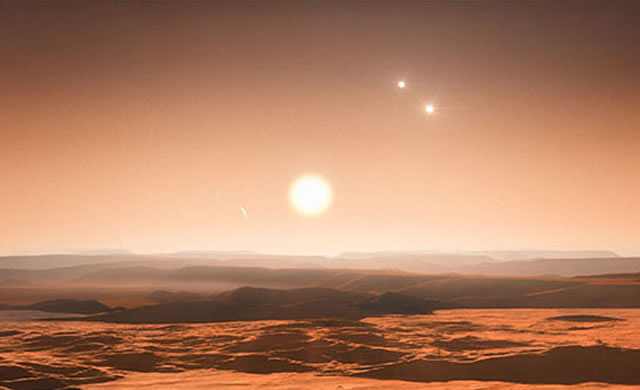
Un’equipe di astronomi ha combinato nuove osservazioni di Gliese 667C con dati preesistenti di HARPS, montato sul telescopio da 3,6 metri dell’ESO in Cile, per rivelare un sistema con almeno 6 pianeti. Tre di questi pianeti, un record, sono super-Terre che si trovano nella zona intorno alla stella in cui potrebbe esistere acqua allo stato liquido, rendendoli possibili candidati per la presenza della vita. Questo é il primo sistema in cui la zona abitabile sia al completo, piena di pianeti.
Gliese 667C é una stella molto ben studiata. Ha un massa di poco più di un terzo della massa del Sole, fa parte di un sistema stellare triplo noto come Gliese 667 (o anche GJ 667) a 22 anni luce da noi, nella costellazione dello Scorpione. É perciò molto vicina a noi – proprio nelle vicinanze del Sole – e molto più vicina dei sistemi stellari studiati dai cercatori di pianeti come il telescopio spaziale Keplero. Alcuni studi precedenti su Gliese 667C avevano trovato che la stella ospita tre pianeti giganti (eso0939, eso1214), di cui uno nella zona abiltabile. Ora un’equipe di astronomi guidata da Guillem Anglada-Escudé dell’Università di Göttingen, Germania, e da Mikko Tuomi dell’Università di Hertfordshire, Regno Unito, ha riesaminato il sistema. Hanno aggiunto al quadro esistente nuove osservazioni con HARPS e dati dall’Osservatorio W.M. Keck, dal telescopio Magellano e dal VLT (Very Large Telescope) dell’ESO. L’equipe ha trovato la prova dell’esistenza di vari pianeti intorno alla stella fino a un massimo di sette. Questi pianeti sono in orbita intorno alla più debole delle stelle di un sistema triplo. Visti da uno di questi pianeti appena scoperti, i due soli più lontani apparirebbero come un paio di stelle molto brillanti, visibili anche di giorno, mentre di notte farebbero tanta luce quanto la Luna piena. I nuovi pianeti riempiono completamente la zona abitabile di Gliese 667C, poiché non ci sono altre orbite stabili in cui un pianeta possa restare alla giusta distanza dalla stella.
Fonte/Leggi tutto → ESO.org
A team of astronomers has combined new observations of Gliese 667C with existing data from HARPS at ESO’s 3.6-metre telescope in Chile, to reveal a system with at least six planets. A record-breaking three of these planets are super-Earths lying in the zone around the star where liquid water could exist, making them possible candidates for the presence of life. This is the first system found with a fully packed habitable zone.
Gliese 667C is a very well-studied star. Just over one third of the mass of the Sun, it is part of a triple star system known as Gliese 667 (also referred to as GJ 667), 22 light-years away in the constellation of Scorpius (The Scorpion). This is quite close to us — within the Sun’s neighbourhood — and much closer than the star systems investigated using telescopes such as the planet-hunting Kepler space telescope. Previous studies of Gliese 667C had found that the star hosts three planets (eso0939, eso1214) with one of them in the habitable zone. Now, a team of astronomers led by Guillem Anglada-Escudé of the University of Göttingen, Germany and Mikko Tuomi of the University of Hertfordshire, UK, has reexamined the system. They have added new HARPS observations, along with data from ESO’s Very Large Telescope, the W.M. Keck Observatory and the Magellan Telescopes, to the already existing picture. The team has found evidence for up to seven planets around the star. These planets orbit the third fainter star of a triple star system. Viewed from one of these newly found planets the two other suns would look like a pair of very bright stars visible in the daytime and at night they would provide as much illumination as the full Moon. The new planets completely fill up the habitable zone of Gliese 667C, as there are no more stable orbits in which a planet could exist at the right distance to it.
Source/Continue reading → ESO.org





















